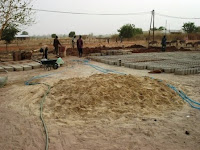Ever since getting back to Kayemor after our Inter-Service Training (IST), I feel like I have done nothing but sit in meetings. This obviously is not true, but I have sat in on A LOT of meetings. I’m not complaining, though, because most of these meetings have been organized specifically to help me with my work. When I first got back to Kayemor, I met with my host father and several other men and women that are involved in development work through “Peñc mi,” the local organization that works with Symbiose, a local NGO that is associated with and financially supported by the Austrian-based organization Horizont3000. In these first couple meetings, we talked about the work that Kate, the PCV in Kayemor before me, had done and how I could build upon that work (such as expanding the seed extension program to more farmers and villages, and supervising the construction and use of the seed storage facility that Kate had started raising money for when she was a PCV), as well as what new things I could do (such as start a school garden and a large, central tree nursery in Kayemor). As far as expanding the seed extension program, we decided it would be helpful if one of Peñc mi’s “animateurs” (essentially a person that has been trained in how to lead a village meeting [they have them pretty often here]) would go with me to each of the 23 villages in the “communauté rurale de Kayemor” (i.e., the small region of which Kayemor is the “capital” for lack of a better word) and have a meeting with the villagers, so I could meet them, so the animateur could explain my role in the community as a PCV and explain the seed extension program (since not all the farmers are necessarily aware of it), and so the villagers could select one farmer to act as the village “captain” or “relay” between me and all the other farmers in the village who are in the seed extension program. This relay will get special training from me on all the crops I will extend through the program (such as proper planting timing and spacing, weeding timing, integrated pest management techniques, etc.) so he/she is familiar with all of them (even if he/she will only actually farm one him/herself) and then the relay will be able to help the other farmers in his/her village if they have questions or concerns about the crop they’re growing. This is important because I will be extending seeds to over 100 farmers in over 15 villages, and, no matter how hard I try, I won’t be able to visit every farmer as often as I should (like every week or every other week), so the relay will (as the title suggests) act as a relay between me and the farmers – relaying information, questions, concerns, and suggestions back and forth. This will also build the capacity of local farmers, which is a primary goal of Peace Corps and a key to the sustainability of the program. Once this plan was agreed upon, we made a plan of action and chose which village I would go to on which day with which animateur. So far I have been to a handful of villages and have found the meetings very helpful.
As far as the other meetings are concerned, I had a 2-day-long meeting in Nioro that was organized by Symbiose because they are expanding the number of communities in which they work, and so they wanted to gather all the community leaders from all the communities they will be working in now to explain their new program and allow people to network. You can learn more about Symbiose and Horizont3000 here: (you can use google to translate these websites into English)
http://base.afrique-gouvernance.net/fr/corpus_dph/fiche-dph-735.htmlhttp://base.afrique-gouvernance.net/fr/corpus_organismes/fiche-organismes-156.htmlhttp://www.horizont3000.at/Other meetings I have attended have been lead by my host father in nearby villages regarding environmental concerns that the community in general has – namely concerns about the rapid rate of deforestation of the area (because everyone uses the trees for firewood to cook as well as for building fences and tools, and very few people plant new trees and those that are planted are often eaten by cows and goats – this is a big problem in Africa in general as well as the rest of the developing world) and the poor quality of the soil (because of deforestation, erosion, over-grazing, and continuous agriculture without adding soil amendments such as manure). Concerns about climate change were brought up, too, though they obviously didn’t use that word – the older men and women just talked about how the hot season is hotter than it used to be and how the cool season isn’t nearly as cool as it used to be and how the rains come later than they used to. Once the concerns were expressed, the villages talked about how they can address their environmental concerns by planting more trees (hence the importance of a big, central tree nursery in Kayemor for all the surrounding villages), using crop rotations, using manure to fertilize their fields, etc. I know that a lot of this was probably just talk, but talk is certainly the place to start, and the fact that they all recognize these problems means that they will hopefully be really motivated to try to make some changes to make things better.
























